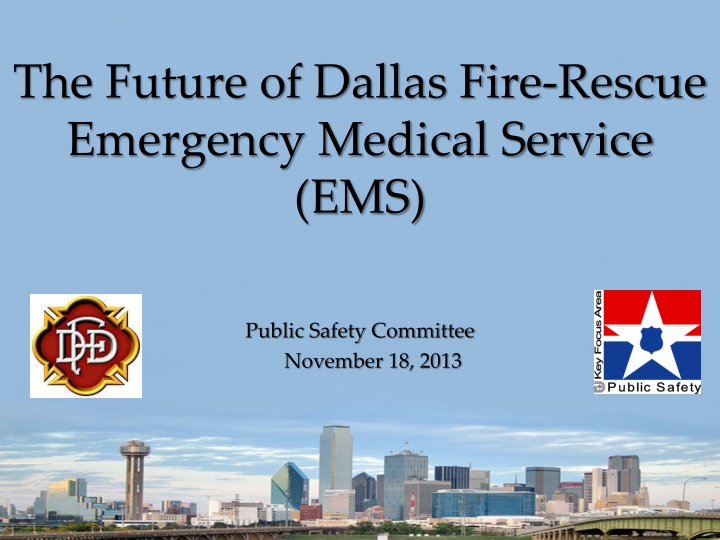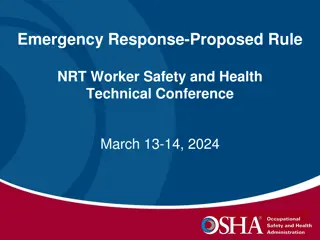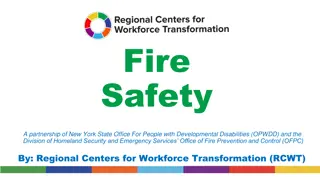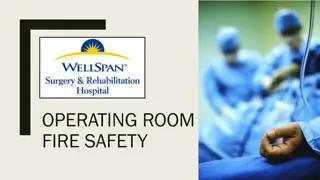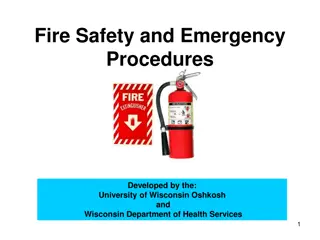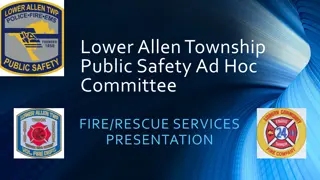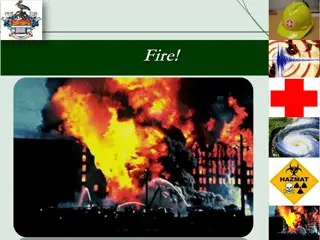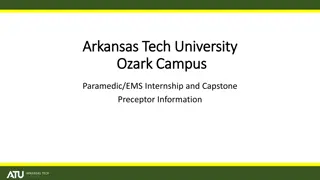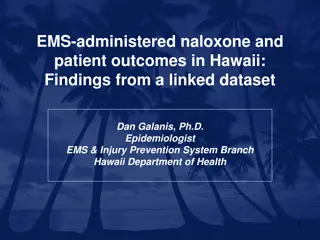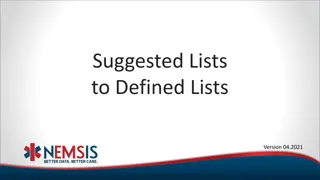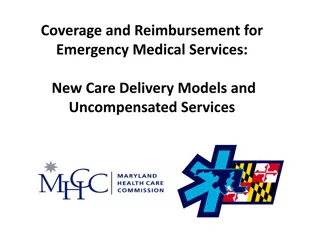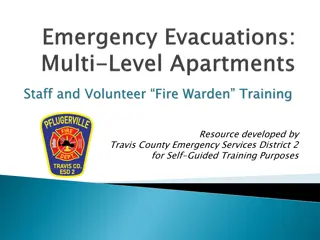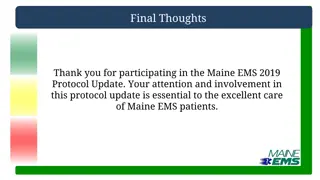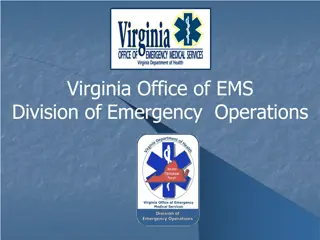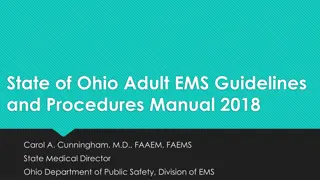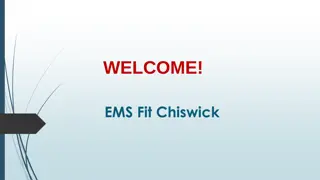The Future of Dallas Fire-Rescue Emergency Medical Service (EMS)
This presentation outlines the evolution of prehospital care by Dallas Fire-Rescue Department, emphasizing the need for change in a rapidly evolving medical care system. It discusses the historical context, focus on prevention, and parallels with healthcare industry changes.
Download Presentation

Please find below an Image/Link to download the presentation.
The content on the website is provided AS IS for your information and personal use only. It may not be sold, licensed, or shared on other websites without obtaining consent from the author.If you encounter any issues during the download, it is possible that the publisher has removed the file from their server.
You are allowed to download the files provided on this website for personal or commercial use, subject to the condition that they are used lawfully. All files are the property of their respective owners.
The content on the website is provided AS IS for your information and personal use only. It may not be sold, licensed, or shared on other websites without obtaining consent from the author.
E N D
Presentation Transcript
The Future of Dallas Fire-Rescue Emergency Medical Service (EMS) { Public Safety Committee November 18, 2013
Purpose: The purpose of this presentation is to outline to the Public Safety Committee an evolution in the provision of prehospital care to the citizens of Dallas as delivered by the Dallas Fire-Rescue Department.
As we look into the future of prehospital emergency medical care, we are called upon to evaluate our role and the possible need for change in the context of a rapidly evolving medical care system. We must look at what we have learned during the past century and create a vision for the future of fire-based EMS. Harold Schaltberger, General President International Association of Fire Fighters
The history of the American fire service and Dallas Fire-Rescue Department has been one of adapting to changing environments: Before the 1970 s, focus was to fight fires with more equipment and personnel Implementation of EMS in the 1970 s Increased awareness of fire losses in the 1970 s Increased focus on Fire Prevention Changes in equipment and procedures (Self Contained Breathing Apparatus {SCBA}, Thermal Imagers) Upgrading technology It s now time for the evolution to continue
Focus on Prevention Yields Results America Burning Policy paper published in 1973 National Commission on Fire Prevention and Control Intended to address problems that existed in fire fighting at that time (annual numbers) Over 6,200 lives to fire Over 300,000 injuries Over $11 billion fire loss ($54 billion if adjusted to today s dollar value) Due to increased attention to prevention and legislative actions, in 2010: 2,640 lives lost 13,350 injuries $7.5 billion fire loss
Evolution in delivery of healthcare Similar focus now coming into play in the healthcare industry National legislative changes focusing on healthcare delivery Scientific research papers and reports Much discussion in trade journals Discussion at all legislative levels
EMS Trends DFR responded to first EMS call on November 6, 1972 FY 1972-1973: 40,249 responses, 16 ambulances FY 2012-2013: 193,820 responses, 40 front-line Rescues and 3 Peak Demand Rescues Over the past five year, we have experienced an average annual increase in response volume of 3% (FY13: 6.5%)
EMS Call Volumes and Number of Rescues 1972-2013 250,000 65 193,820 200,000 182,035 55 163,110 150,395 150,000 127,565 45 41.9 41.9 108,855 39 100,000 35 34.17 74,974 33.3 51,251 50,106 40,249 27.5 50,000 25 22 18.42 18.42 16 0 15 1972 1977 1982 1987 1992 1997 2002 2007 2012 2013 Responses Rescues
Whats been going on nationally? Three major legislative initiatives: Health Insurance Portability and Accountability Act (HIPAA), 1996 Health Information Technology for Economic and Clinical Health Act (HITECH), 2009 Patient Protection and Affordable Care Act (PPACA), 2010
National EMS Industry Trends Increasing call volumes Increasing costs of service delivery Budget battles forced system efficiencies System overuse/abuse issues Uninsured/ underinsured patients Call Response Optimization Private vs. Fire-based EMS Evidence-based protocols and procedures Community Paramedic Programs Community Healthcare Education Campaigns 9-1-1 Public Education Campaigns
DFR EMS FY13 Statistical Review
FY13 DFR EMS Statistics 41.9 Rescues: 40 front-line, 3 Peak Demand 193,820 calls (6.5% increase from FY12) 6:01 response time 69,000 transports Average calls per Rescue: Annual Cost of Service: $126,480,348* Net Amount Billed: Net Amount Collected: Accounts Receivable: 4,625 $44,572,702 $20,555,161 $24,017,541 * Per Public Consulting Group report published November 26, 2012
Patient Disposition Breakdown Patient Transported - 43% Patient Refused Transport - 42% No Sick or Injured - 9% No Patient Found - 3% Refused by EMS - 3% 3% 3% 9% 43% 42%
Payer Mix Private Insurance - 11% Medicare/Medicaid - 32% Self Pay - 54% Other - 3% 3% 11% 54% 32%
EMS Claims FY13 Claims with payment - 44% Claims without payment - 51% Claims not billed - 5% 5% 44% 51%
EMS Frequent Utilizers Payer Information Uninsured - 27% Medicare/Medicaid - 29% Private Insurance - 44% 27% 44% 29%
Possible Future of U.S. Healthcare Industry
National Trends Decreasing number of primary care physicians Health care costs per capita grown an average 2.4 percentage points faster than the Gross Domestic Product (GDP) since 1970 Half of health care spending is used to treat just 5% of the population Increasing age of the population. The percentage of the U.S. population 65 or older: 16% by 2020, 21% by 2050 Increasing per capita cost of healthcare delivery, currently estimated by the Center for Disease Control at $8,400
National Trends Insurance coverage with Medicaid is expected to increase by 16 million people Increasing usage of 9-1-1 systems Changing reimbursement models 2% decrease in Medicare reimbursement effective April 1, 2013 Shift to valuebased reimbursement models in the next few years Bundling of reimbursements
Likely Future Developments in EMS Additional Medicare/Medicaid cuts on traditional service delivery Possible impacts from medical device tax Increased call volumes Quality of service and patient outcomes tied to reimbursement Potential reimbursements for non- traditional service delivery models Creation of alternate care delivery mechanisms
DFR Internal Review Process
Internal Review Process: 2006 Vision Process 2006 Led by Dr. Isaacs and EMS leadership Involved over 100 DFR employees and administrators, in conjunction with outside resources Vision process: Developed 52 recommendations for the future of DFR EMS
Internal Review Process: 2012-13 Steering Committee developed in Summer of 2012 Focus Groups met in December 2012 and January 2013 Six workgroups representing internal and external stakeholders SWOT (Strengths, Weaknesses, Opportunities and Threats) analysis Provided invaluable insight and input Review Committee met in January and February 2013 16 members Recommended continuation of implementing Vision recommendations Analyzed data from Focus Group process Identified key areas of concern
DFR EMS Needs to Respond Based on projected impacts of healthcare reform initiatives and trends in service delivery, the time has come to evolve the current EMS service delivery model.
Mobile Community Healthcare Program (MCHP)
Community Paramedic Programs Programs in place since early 2000 s Designed to be an extension of primary care Address the following healthcare needs: Wellness and prevention Primary care for the chronically ill Post discharge care Connecting patients with various community resources Patient advocacy
Community Paramedic Programs Health care reform has enhanced the viability and necessity of these programs Started in rural settings to address gaps between physicians Have since expanded internationally and into the urban environment Have proven to have a number of benefits for the patients served and the agencies who implemented these programs
Mobile Community Healthcare Program (MCHP) New DFR program Will integrate Dallas Fire-Rescue EMS with premier Dallas hospitals and other healthcare agencies to provide scheduled, individualized care to its enrolled high-risk patient populations Will assist DFR and partner agencies in meeting the Institute for Healthcare Improvement s Triple Aim Objectives: Improved patient experience of care Improving the health of populations Reducing the per capita cost of healthcare
DFR MCHP Personnel selected through application process Will receive additional training: Program training: MedStar Full continuum of care for chronically ill patients Social services Mental health training Initial Staffing: One Lieutenant and 4 Paramedics Will contract with various area healthcare provider agencies to provide services Estimated go-live date January 2014
DFR MCHP The MCHP paramedic will perform a basic assessment of the patient in their home to include: Medical requirements Medication review Individual healthcare education Social services needs Mental health services needs Patient advocacy will be the highest priority Will work with assigned physicians, case managers and others to: Improve the patient quality of care Improve the patients health condition Reduce utilization of EMS and Emergency Departments
DFR MCHP Initial MCHP programs: Trauma discharge readmission prevention Pediatric asthma readmission prevention Frequent utilizers program Congestive heart failure follow-up
MCHP Sample programs (based on contract obligations and internal decisions): Post-discharge readmission prevention: Acute Myocardial Infarction (aka heart attack) Heart Failure Pneumonia Chronic Obstructive Pulmonary Disease Elective hip or knee replacement End stage renal disease
MCHP Sample programs (continued): Serial inebriate program Frequent system utilizers Mental health follow-up Hospice and palliative care System Overuse Program Geriatric Monitoring Program Many, many more options
Service Delivery Evolution
DFR EMS is Responding Current model requires tremendous subsidy and continues to escalate in cost and losses Evaluate and implement a multiple service delivery model consisting of seven levels of response capabilities, along with appropriate training and staffing levels Enhanced dispatch program Additional program options for consideration Community Education EMS Field Training
Benefits Supported by Medical Direction and DFR administration Helps to stabilize call volume (possibly decrease) Allows for reallocation (and possibly expansion) of resources to handle call volumes and needs of the community Significant cost avoidance over the five-year projection Will help us meet established response time goals for critical calls, by allowing flexibility for other EMS calls types Will serve to distribute call types to appropriate resource response unit types
In large urban centers, the tiered ambulance system can be used to reduce response time intervals to critical calls, primarily through the use of sophisticated dispatch protocols. (Calculating your EMS Service s Average Cost of Service and Unit Hour Analysis , J.R. Henry Consulting Inc., 2011)
